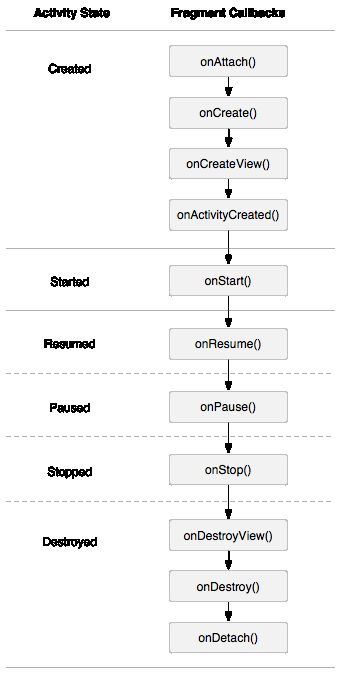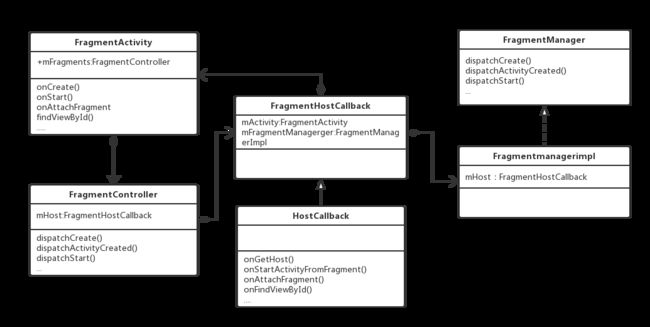Fragment运行机制源码分析(一)
尊重原创:http://blog.csdn.net/yuanzeyao/article/details/52822315
Fragment是Android3.0中推出的,目的是方便屏幕适配,虽然推出时间比较早,但是由于Fragment本身存在着各种Bug,并且使用起来比Activity复杂得多,所以真正掌握Fragment运行机制的同学并不多。在网上经常可以看到开发者对Fragment各种吐槽,认为在App中根本没有必要使用Fragment,因为使用View也可以完成Fragment的一样的功能,对于这种说法也不完全错,我们公司也是因为Fragment存在各种bug,从而自己写了一套类似Fragment机制的框架,并且使用起来非常简单,有bug自己也非常容易修复。但是我个人认为毕竟Fragment是google提供的,并会长期维护,所以相信以后Fragment会越来越稳定,所以我们还是有必要理解Fragment的运行机制,从而当我们使用过程中出现Bug时,我们有办法进行处理。由于Fragment是在3.0系统引入,所以对于2.x系统,如果想使用Fragment,那么需要依赖support_v4包,对于不同版本的support_v4包源码并不一样(support_v4包的源码和系统中Fragment的源码也不一定一样),本系列文章使用的support_v4版本是23.2.1.
简单介绍本系列文章目录:
- Fragmeng生命周期
- Fragment和Activity生命周期如何联动
- FragmentTransaction的add,replace,remove,show,hide等操作都做了什么
- Fragment的销毁和重建机制
- addToBackStack系列方法和popBackStack系列方法源码解析
- 无UI Fragment的使用
- Fragment动画机制分析
Fragment生命周期
以上内容就是本系列文章会详细介绍的,那么我们先来看看Fragment的生命周期,在具体介绍生命周期之前,我们看看官方给出的生命周期图:

从上图可以看出Fragment的生命周期和Activity的生命周期极其类似,只不过生命周期分得更加细致,例如当Activity的生命周期进入onCreate阶段时,那么该Activty中的Fragment中的onAttach,onCreate,onCreateView,onActivityCreated等方法均会被调用。不同的是,Activity的生命周期是被Android系统(严格说是AMS)管理,Fragment的生命周期是被所属Activity管理。那么Activity是如何管理Fragment的生命周期呢?他们的生命周期是如何联动起来的呢?下面我就来为您解答这两个问题。
Fragment和Activity生命周期联动机制
同样在介绍Activity如何管理Fragment生命周期之前,我们先来看一个类图。

从这种图里面我们可以获取一下信息:
- 如果要使用Fragment,那么你的Activity需要继承FragmentActivity(本系列文章讨论的都是support库的Fragment).
- FragmentActivity中有一个属性:mFragments,该属性类型是FragmentController.
- FragmentController类中有一个属性mHost,类型是FragmentHostCallback,它是一个抽象类,实现者是HostCallback.
- FragmentHostCall有两个重要的属性:mActivity和,mFragmentManager. mActivity就是前面说的FragmentActivity,而mFragmentManager是FragmentManagerImpl类型.
- FragmentManagerImpl从名字看来就是用来管理Fragment的,它实现了FragmentManager接口,并且它有一个mHost属性,类型为FragmentHostBack.
- FragmentActivity可以通过mFragment调用到FragmentManager里面的逻辑.
- FragmentManager可以通过mHost调用到FragmentActivity中的逻辑.
分析完类图之后,我们知道FragmentActivity和FragmentManager之间可以通过FragmentHostCallback进行互相调用,那么接下来我们就从代码的角度看看我们是如何交互的。
代码 1:FragmentActivity的onCreate方法
/**
* Perform initialization of all fragments and loaders.
*/
@SuppressWarnings("deprecation")
@Override
protected void onCreate(@Nullable Bundle savedInstanceState) {
mFragments.attachHost(null /*parent*/);
super.onCreate(savedInstanceState);
//....忽略部分代码
mFragments.dispatchCreate();
}为了便于大家分析,我删除了onCreate中一些不相干的逻辑。可以看到在onCreate方法的第一句就调用了mFragment的attachHost方法,经过前面的分析,mFragments就是FragmentController对象,我们先来看看mFragment是如何赋值的。
代码2:FragmentActivity的mFragments属性初始化
final FragmentController mFragments = FragmentController.createController(new HostCallbacks());从这里可以知道使用HostCallBacks对FragmentController中的mHost属性进行初始化。
接下来我们进入到FragmentController的attachHost方法看看。
代码3:FragmentController的attachHost方法
/**
* Attaches the host to the FragmentManager for this controller. The host must be
* attached before the FragmentManager can be used to manage Fragments.
*/
public void attachHost(Fragment parent) {
mHost.mFragmentManager.attachController(
mHost, mHost /*container*/, parent);
}attachHost方法远比我们想象的简单,里面就是调用了mHost.mFragmentManager的attachController方法。通过前面的分析,其实就是调用了FragmentManagerImpl的attachController方法,所以我们顺藤摸瓜,进入FragmentManagerImpl看看。
代码 4:FragmentManagerImpl 的attachController
public void attachController(FragmentHostCallback host,
FragmentContainer container, Fragment parent) {
if (mHost != null) throw new IllegalStateException("Already attached");
mHost = host;
mContainer = container;
mParent = parent;
}attachController方法也是相当的简单,就是对FragmentManager中的mHost,mContainer,mParent三个属性进行赋值。
到这里我们就知道FragmentActivity和FragmentManager是如何关联起来的,接下来我们看看Activity是如何管理Fragment的生命周期的。
在FragmentActivity的onCreate方法中还调用了一个方法
mFragments.dispatchCreate();同样,我们进入到FragmentController的dispatchCreate方法
代码5 :FragmentController的dispatchCreate方法
/**
* Moves all Fragments managed by the controller's FragmentManager
* into the create state.
* Call when Fragments should be created.
*
* @see Fragment#onCreate(Bundle)
*/
public void dispatchCreate() {
mHost.mFragmentManager.dispatchCreate();
}可以看到FragmentController并没有任何逻辑,仅仅是调用了FragmentManagerImpl的同名方法
代码6 :FragmentManagerImpl的dispatchCreate方法
public void dispatchCreate() {
mStateSaved = false;
moveToState(Fragment.CREATED, false);
}dispatchCreate方法里面调用了一个叫moveToState的方法,同样,细心的同学会发现Activity的其他生命周期方法(onStart,onResume..)都会调用到FragmentManagerImpl的dispatchXXX的方法中,最终都调用到了moveToState这个方法,moveToState这个方法有多个同名的方法,最终调用的代码如下:
代码 7:FragmentManagerImpl的movetoState方法
void moveToState(int newState, int transit, int transitStyle, boolean always) {
if (mHost == null && newState != Fragment.INITIALIZING) {
throw new IllegalStateException("No host");
}
if (!always && mCurState == newState) {
return;
}
mCurState = newState;
if (mActive != null) {
boolean loadersRunning = false;
for (int i=0; iif (f != null) {
moveToState(f, newState, transit, transitStyle, false);
if (f.mLoaderManager != null) {
loadersRunning |= f.mLoaderManager.hasRunningLoaders();
}
}
}
if (!loadersRunning) {
startPendingDeferredFragments();
}
if (mNeedMenuInvalidate && mHost != null && mCurState == Fragment.RESUMED) {
mHost.onSupportInvalidateOptionsMenu();
mNeedMenuInvalidate = false;
}
}
} moveToState的逻辑比较清晰:
- 使用mCurState保存传入进来的状态,例如onCreate的状态是Fragment.CREATED
检查mActive列表是否为空(mActive保存的是Fragment列表),如果不为空,那么遍历此列表,然后调用另一个moveToState方法。这个moveToState就是Activity管理Fragment生命周期的核心所在。
在分析此moveToState之前,先简单介绍Fragment的状态:
static final int INITIALIZING = 0; // Not yet created.
static final int CREATED = 1; // Created.
static final int ACTIVITY_CREATED = 2; // The activity has finished its creation.
static final int STOPPED = 3; // Fully created, not started.
static final int STARTED = 4; // Created and started, not resumed.
static final int RESUMED = 5; // Created started and resumed.
int mState = INITIALIZING;在Fragment中定义了6个状态,分包代表了当前Fragment的状态,和生命周期一一对应,每个Fragment创建时默认状态就是INITIALIZING.
代码 8 :FragmentManagerImpl中的另一个moveToState。
void moveToState(Fragment f, int newState, int transit, int transitionStyle,
boolean keepActive) {
// Fragments that are not currently added will sit in the onCreate() state.
if ((!f.mAdded || f.mDetached) && newState > Fragment.CREATED) {
newState = Fragment.CREATED;
}
if (f.mRemoving && newState > f.mState) {
// While removing a fragment, we can't change it to a higher state.
newState = f.mState;
}
// Defer start if requested; don't allow it to move to STARTED or higher
// if it's not already started.
if (f.mDeferStart && f.mState < Fragment.STARTED && newState > Fragment.STOPPED) {
newState = Fragment.STOPPED;
}
if (f.mState < newState) {
// For fragments that are created from a layout, when restoring from
// state we don't want to allow them to be created until they are
// being reloaded from the layout.
if (f.mFromLayout && !f.mInLayout) {
return;
}
if (f.mAnimatingAway != null) {
// The fragment is currently being animated... but! Now we
// want to move our state back up. Give up on waiting for the
// animation, move to whatever the final state should be once
// the animation is done, and then we can proceed from there.
f.mAnimatingAway = null;
moveToState(f, f.mStateAfterAnimating, 0, 0, true);
}
switch (f.mState) {
case Fragment.INITIALIZING:
if (DEBUG) Log.v(TAG, "moveto CREATED: " + f);
if (f.mSavedFragmentState != null) {
f.mSavedFragmentState.setClassLoader(mHost.getContext().getClassLoader());
f.mSavedViewState = f.mSavedFragmentState.getSparseParcelableArray(
FragmentManagerImpl.VIEW_STATE_TAG);
f.mTarget = getFragment(f.mSavedFragmentState,
FragmentManagerImpl.TARGET_STATE_TAG);
if (f.mTarget != null) {
f.mTargetRequestCode = f.mSavedFragmentState.getInt(
FragmentManagerImpl.TARGET_REQUEST_CODE_STATE_TAG, 0);
}
f.mUserVisibleHint = f.mSavedFragmentState.getBoolean(
FragmentManagerImpl.USER_VISIBLE_HINT_TAG, true);
if (!f.mUserVisibleHint) {
f.mDeferStart = true;
if (newState > Fragment.STOPPED) {
newState = Fragment.STOPPED;
}
}
}
f.mHost = mHost;
f.mParentFragment = mParent;
f.mFragmentManager = mParent != null
? mParent.mChildFragmentManager : mHost.getFragmentManagerImpl();
f.mCalled = false;
f.onAttach(mHost.getContext());
if (!f.mCalled) {
throw new SuperNotCalledException("Fragment " + f
+ " did not call through to super.onAttach()");
}
if (f.mParentFragment == null) {
mHost.onAttachFragment(f);
}
if (!f.mRetaining) {
f.performCreate(f.mSavedFragmentState);
}
f.mRetaining = false;
if (f.mFromLayout) {
// For fragments that are part of the content view
// layout, we need to instantiate the view immediately
// and the inflater will take care of adding it.
f.mView = f.performCreateView(f.getLayoutInflater(
f.mSavedFragmentState), null, f.mSavedFragmentState);
if (f.mView != null) {
f.mInnerView = f.mView;
if (Build.VERSION.SDK_INT >= 11) {
ViewCompat.setSaveFromParentEnabled(f.mView, false);
} else {
f.mView = NoSaveStateFrameLayout.wrap(f.mView);
}
if (f.mHidden) f.mView.setVisibility(View.GONE);
f.onViewCreated(f.mView, f.mSavedFragmentState);
} else {
f.mInnerView = null;
}
}
case Fragment.CREATED:
if (newState > Fragment.CREATED) {
if (DEBUG) Log.v(TAG, "moveto ACTIVITY_CREATED: " + f);
if (!f.mFromLayout) {
ViewGroup container = null;
if (f.mContainerId != 0) {
container = (ViewGroup)mContainer.onFindViewById(f.mContainerId);
if (container == null && !f.mRestored) {
throwException(new IllegalArgumentException(
"No view found for id 0x"
+ Integer.toHexString(f.mContainerId) + " ("
+ f.getResources().getResourceName(f.mContainerId)
+ ") for fragment " + f));
}
}
f.mContainer = container;
f.mView = f.performCreateView(f.getLayoutInflater(
f.mSavedFragmentState), container, f.mSavedFragmentState);
if (f.mView != null) {
f.mInnerView = f.mView;
if (Build.VERSION.SDK_INT >= 11) {
ViewCompat.setSaveFromParentEnabled(f.mView, false);
} else {
f.mView = NoSaveStateFrameLayout.wrap(f.mView);
}
if (container != null) {
Animation anim = loadAnimation(f, transit, true,
transitionStyle);
if (anim != null) {
setHWLayerAnimListenerIfAlpha(f.mView, anim);
f.mView.startAnimation(anim);
}
container.addView(f.mView);
}
if (f.mHidden) f.mView.setVisibility(View.GONE);
f.onViewCreated(f.mView, f.mSavedFragmentState);
} else {
f.mInnerView = null;
}
}
f.performActivityCreated(f.mSavedFragmentState);
if (f.mView != null) {
f.restoreViewState(f.mSavedFragmentState);
}
f.mSavedFragmentState = null;
}
case Fragment.ACTIVITY_CREATED:
case Fragment.STOPPED:
if (newState > Fragment.STOPPED) {
if (DEBUG) Log.v(TAG, "moveto STARTED: " + f);
f.performStart();
}
case Fragment.STARTED:
if (newState > Fragment.STARTED) {
if (DEBUG) Log.v(TAG, "moveto RESUMED: " + f);
f.performResume();
f.mSavedFragmentState = null;
f.mSavedViewState = null;
}
}
} else if (f.mState > newState) {
switch (f.mState) {
case Fragment.RESUMED:
if (newState < Fragment.RESUMED) {
if (DEBUG) Log.v(TAG, "movefrom RESUMED: " + f);
f.performPause();
}
case Fragment.STARTED:
if (newState < Fragment.STARTED) {
if (DEBUG) Log.v(TAG, "movefrom STARTED: " + f);
f.performStop();
}
case Fragment.STOPPED:
if (newState < Fragment.STOPPED) {
if (DEBUG) Log.v(TAG, "movefrom STOPPED: " + f);
f.performReallyStop();
}
case Fragment.ACTIVITY_CREATED:
if (newState < Fragment.ACTIVITY_CREATED) {
if (DEBUG) Log.v(TAG, "movefrom ACTIVITY_CREATED: " + f);
if (f.mView != null) {
// Need to save the current view state if not
// done already.
if (mHost.onShouldSaveFragmentState(f) && f.mSavedViewState == null) {
saveFragmentViewState(f);
}
}
f.performDestroyView();
if (f.mView != null && f.mContainer != null) {
Animation anim = null;
if (mCurState > Fragment.INITIALIZING && !mDestroyed) {
anim = loadAnimation(f, transit, false,
transitionStyle);
}
if (anim != null) {
final Fragment fragment = f;
f.mAnimatingAway = f.mView;
f.mStateAfterAnimating = newState;
final View viewToAnimate = f.mView;
anim.setAnimationListener(new AnimateOnHWLayerIfNeededListener(
viewToAnimate, anim) {
@Override
public void onAnimationEnd(Animation animation) {
super.onAnimationEnd(animation);
if (fragment.mAnimatingAway != null) {
fragment.mAnimatingAway = null;
moveToState(fragment, fragment.mStateAfterAnimating,
0, 0, false);
}
}
});
f.mView.startAnimation(anim);
}
f.mContainer.removeView(f.mView);
}
f.mContainer = null;
f.mView = null;
f.mInnerView = null;
}
case Fragment.CREATED:
if (newState < Fragment.CREATED) {
if (mDestroyed) {
if (f.mAnimatingAway != null) {
// The fragment's containing activity is
// being destroyed, but this fragment is
// currently animating away. Stop the
// animation right now -- it is not needed,
// and we can't wait any more on destroying
// the fragment.
View v = f.mAnimatingAway;
f.mAnimatingAway = null;
v.clearAnimation();
}
}
if (f.mAnimatingAway != null) {
// We are waiting for the fragment's view to finish
// animating away. Just make a note of the state
// the fragment now should move to once the animation
// is done.
f.mStateAfterAnimating = newState;
newState = Fragment.CREATED;
} else {
if (DEBUG) Log.v(TAG, "movefrom CREATED: " + f);
if (!f.mRetaining) {
f.performDestroy();
} else {
f.mState = Fragment.INITIALIZING;
}
f.mCalled = false;
f.onDetach();
if (!f.mCalled) {
throw new SuperNotCalledException("Fragment " + f
+ " did not call through to super.onDetach()");
}
if (!keepActive) {
if (!f.mRetaining) {
makeInactive(f);
} else {
f.mHost = null;
f.mParentFragment = null;
f.mFragmentManager = null;
f.mChildFragmentManager = null;
}
}
}
}
}
}
if (f.mState != newState) {
Log.w(TAG, "moveToState: Fragment state for " + f + " not updated inline; "
+ "expected state " + newState + " found " + f.mState);
f.mState = newState;
}
}可能有些同学看到这里有些晕,先喝杯茶冷静冷静,让我给你梳理一下这个方法的逻辑。
从整体来看,这个方法包含了很大的一个if..else.所以我们从16行还是看起:
if (f.mState < newState)以Fragment.CREATE为例,此if语句成立(因为此时f.mState是INITIALIZING),所以接下来进入switch语句,为了大家看起来方便,我将switch语句重新copy一份。
switch (f.mState) {
case Fragment.INITIALIZING:
if (DEBUG) Log.v(TAG, "moveto CREATED: " + f);
if (f.mSavedFragmentState != null) {
f.mSavedFragmentState.setClassLoader(mHost.getContext().getClassLoader());
f.mSavedViewState = f.mSavedFragmentState.getSparseParcelableArray(
FragmentManagerImpl.VIEW_STATE_TAG);
f.mTarget = getFragment(f.mSavedFragmentState,
FragmentManagerImpl.TARGET_STATE_TAG);
if (f.mTarget != null) {
f.mTargetRequestCode = f.mSavedFragmentState.getInt(
FragmentManagerImpl.TARGET_REQUEST_CODE_STATE_TAG, 0);
}
f.mUserVisibleHint = f.mSavedFragmentState.getBoolean(
FragmentManagerImpl.USER_VISIBLE_HINT_TAG, true);
if (!f.mUserVisibleHint) {
f.mDeferStart = true;
if (newState > Fragment.STOPPED) {
newState = Fragment.STOPPED;
}
}
}
f.mHost = mHost;
f.mParentFragment = mParent;
f.mFragmentManager = mParent != null
? mParent.mChildFragmentManager : mHost.getFragmentManagerImpl();
f.mCalled = false;
f.onAttach(mHost.getContext());
if (!f.mCalled) {
throw new SuperNotCalledException("Fragment " + f
+ " did not call through to super.onAttach()");
}
if (f.mParentFragment == null) {
mHost.onAttachFragment(f);
}
if (!f.mRetaining) {
f.performCreate(f.mSavedFragmentState);
}
f.mRetaining = false;
if (f.mFromLayout) {
// For fragments that are part of the content view
// layout, we need to instantiate the view immediately
// and the inflater will take care of adding it.
f.mView = f.performCreateView(f.getLayoutInflater(
f.mSavedFragmentState), null, f.mSavedFragmentState);
if (f.mView != null) {
f.mInnerView = f.mView;
if (Build.VERSION.SDK_INT >= 11) {
ViewCompat.setSaveFromParentEnabled(f.mView, false);
} else {
f.mView = NoSaveStateFrameLayout.wrap(f.mView);
}
if (f.mHidden) f.mView.setVisibility(View.GONE);
f.onViewCreated(f.mView, f.mSavedFragmentState);
} else {
f.mInnerView = null;
}
}
case Fragment.CREATED:通过前面的分析,第一个case就可以匹配成功,我们来详细分析这段代码:
- 首先检查f.mSavedFragmentState是否不为null,有过开发经验的同学应该知道,只有销毁并重建才不为null,我们这里这哪是不考虑这种情况,所以第一个if语句不会走。
- 使用FragmentManagerImpl中的属性初始化Fragment相应字段(如mHost)。
- 调用Fragment的onAttach()。
- 调用mHost.onAttachFragment()(通过前面attachController方法可以知道mParentFragment一定是null)
- 调用f.performCreate方法:
void performCreate(Bundle savedInstanceState) {
if (mChildFragmentManager != null) {
mChildFragmentManager.noteStateNotSaved();
}
mState = CREATED;
mCalled = false;
onCreate(savedInstanceState);
if (!mCalled) {
throw new SuperNotCalledException("Fragment " + this
+ " did not call through to super.onCreate()");
}
if (savedInstanceState != null) {
Parcelable p = savedInstanceState.getParcelable(
FragmentActivity.FRAGMENTS_TAG);
if (p != null) {
if (mChildFragmentManager == null) {
instantiateChildFragmentManager();
}
mChildFragmentManager.restoreAllState(p, null);
mChildFragmentManager.dispatchCreate();
}
}
}- performCreate方法其实就是调用了Fragment的onCreate方法
- 调用f.performCreateView方法,其实就是调用Fragment的onCreateView方法
- 调用f.onViewCreated()
到这里这个case也算运行完了,是不是很简单?课时在前面分析Fragment生命周期时,不是说Activity的onCreate阶段还会调用Fragment的onActivityCreated吗?这里为什么执行到onViewCreated就结束了?我们再来回到这个case地方,你会发现这个case并没有break,也没有return ,那么以为着第二个case 也会被执行,我们看看第二个case
case Fragment.CREATED:
if (newState > Fragment.CREATED) {
}
case Fragment.ACTIVITY_CREATED:由于newState==Fragment.CREATED,所以这个case什么都不干。同样后面所有的case都会走,但是由于if语句均不满足,所以此时onActivityCreated语句并没有执行。
当最外层的if语句走完之后,会更新Fragment的状态
if (f.mState != newState) {
Log.w(TAG, "moveToState: Fragment state for " + f + " not updated inline; "
+ "expected state " + newState + " found " + f.mState);
f.mState = newState;
}所以此时Fragment的状态是Fragment.CREATED.
那么onActivityCreated什么时候执行呢?其实此方法并不是在Activity的onCreate阶段执行,而是onStart阶段执行,当你查看FragmentActivity的onStart方法时,你会看到如下代码:
@Override
protected void onStart() {
super.onStart();
if (!mCreated) {
mCreated = true;
mFragments.dispatchActivityCreated();
}
//省略部分代码
// NOTE: HC onStart goes here.
mFragments.dispatchStart();
mFragments.reportLoaderStart();
}大家可以尝试跟踪dispatchActivityCreated方法,最终会调用Fragment的onActivityCreated。
到这里,我们就将moveToStatue的if部分分析完了,那么else部分什么时候会执行呢?其实if部分在对应Fragment从不可见到可见的生命周期方法,而else对应Fragment从可见到不可见的生命周期方法。
今天就分析到这里吧,本篇文章主要分析了Activity和Fragment在onCreate阶段生命周期的联动,以及从源码角度分析Fragment和Activity的联动机制,如果大家喜欢我的文章可以关注我的微信公众号,我会定时给大家推送技术文章….